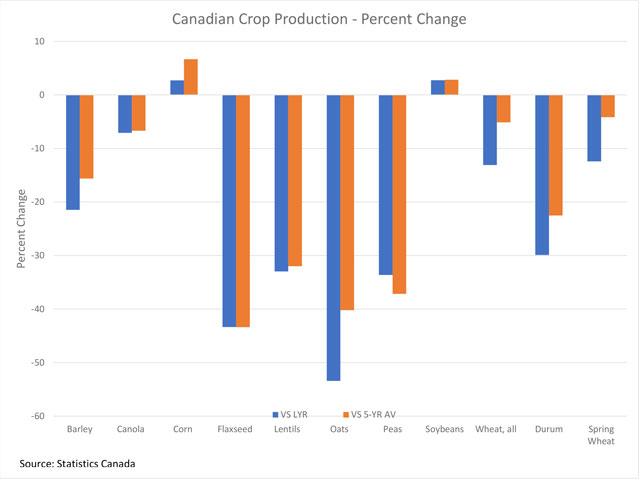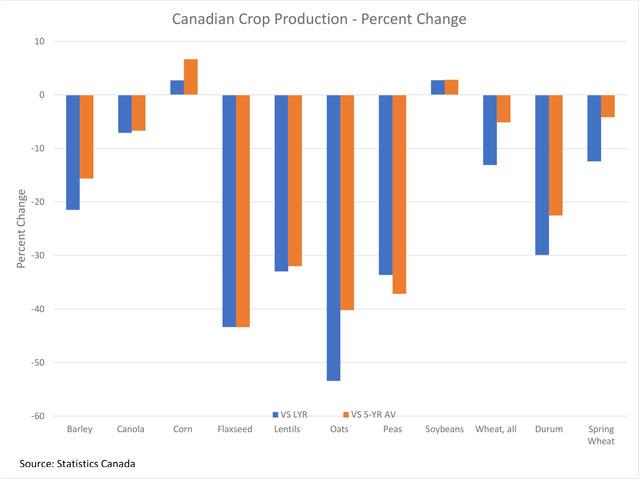Canada Markets
Statistics Canada Revises Production Estimates
For the second time since late August, Statistics Canada has released crop production estimates, this time based on August model data. The agency continues to exclude five of the provinces producing small volumes, which produce roughly 2-4% of the national total and will be included when the next estimates are released in December. The December estimate will be based on producer surveys, so we remain months away from an objective view of the crop's potential.
Today's release points to national principal field crop production of 84.492 million metric tons, down 12.599 metric tons or 13% from 2022-23, while 8% below the five-year average overall.
The largest change made today was found in the estimate for wheat. Statistics Canada revised their forecast for Canada's all-wheat production higher by 362,852 mt to 29.835 million metric tons, down 13.1% from a year ago and 5.1% below the five-year average. If realized, this would be the second-smallest crop produced in eight years, next to the 22.422 mmt estimate for 2021-22.
P[L1] D[0x0] M[300x250] OOP[F] ADUNIT[] T[]
This revision was largely due to a 535,468 mt increase in the spring wheat estimate to 22.637 mmt, down 12.4% from one year ago and 4.2% below the five-year average. Harvested acres for all three prairie provinces were left unchanged in this calculation. The average yield for Manitoba was revised 0.7 bushels per acre higher to 53.8 bpa (57.9 bpa), the Saskatchewan average yield was revised 2.3 bpa higher to 37.4 bpa (45.2 bpa) and the average Alberta yield was revised .5 bpa lower to 47.1 bpa (51.8 bpa) with the five-year average in brackets.
While there were some rumblings that we could see the canola crop revised higher to above 18 mmt in the trade, today's report resulted in a modest reduction in the forecast. Canada's production is estimated at 17.368 mmt, down 193,433 mt from the estimate released in late August. This is down roughly 1.3 mmt or 7.1% from a year ago while 6.7% below the five-year average. Total supplies of 18.9 mmt, including Statistics Canada's 1.5 mmt ending stocks estimate would allow the industry to meet demand that is roughly equal to the 18.6 mmt of domestic and export demand achieved in 2022-23. Demand rationing may be required this crop year based on current estimates.
Another crop where production was revised lower in this report is barley with the estimated production down 81,869 mt to 7.842 mmt. This is down 2.1 mmt or 21.5% from 2022-23 while down 15.6% from the five-year average. Australia's inroads back into the Chinese market will take a large bite out of Canada's export potential, freeing up supplies for the domestic market, while we have seen aggressive buying of U.S. corn over a number of weeks.
As seen on the attached chart of selected crops, production estimates clearly differentiate between crops grown in the prairie provinces as compared to crops grown in Ontario and Quebec, where row crop production is most concentrated.
Statistics Canada revised higher their estimates for corn in Quebec by 1.5 bpa to 151.9 bpa and the Ontario yield higher by 3.2 to 172.9 bpa, while reducing their Manitoba estimate by .7 bpa to 111.8 bpa. The corn crop production estimate is up 2.7% higher than achieved in 2022, while 2.8% higher than the five-year average. It is interesting to note that the 172.9 bpa estimate for Ontario compares to the recent Great Lakes Grain Crop Assessment Tour estimate of 199.9 bpa. Upside to the corn estimate remains a possibility.
There was little change to the soybean estimate, with Canada's soybean estimate at 6.722 mmt the highest seen in five years. National production is estimated 2.7% higher than in 2022 while 2.8% higher than the five-year average.
Cliff Jamieson can be reached at cliff.jamieson@dtn.com
Follow him on X, formerly Twitter, @Cliff Jamieson
(c) Copyright 2023 DTN, LLC. All rights reserved.






Comments
To comment, please Log In or Join our Community .